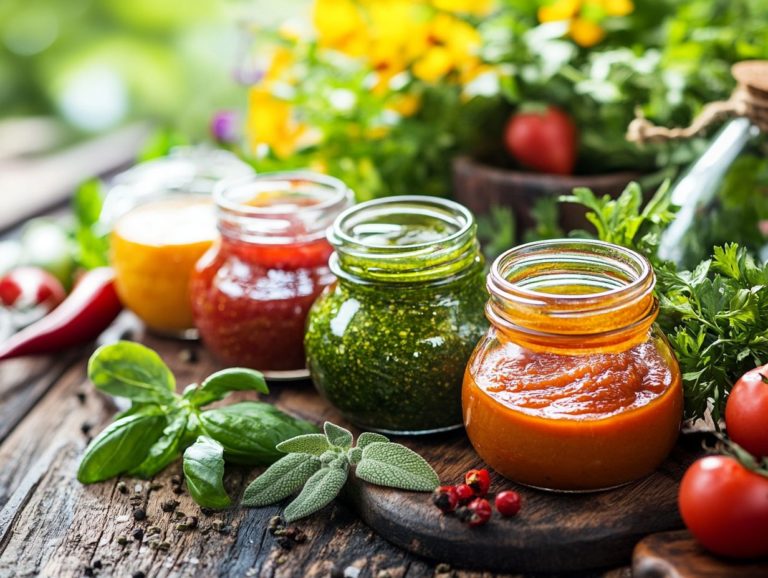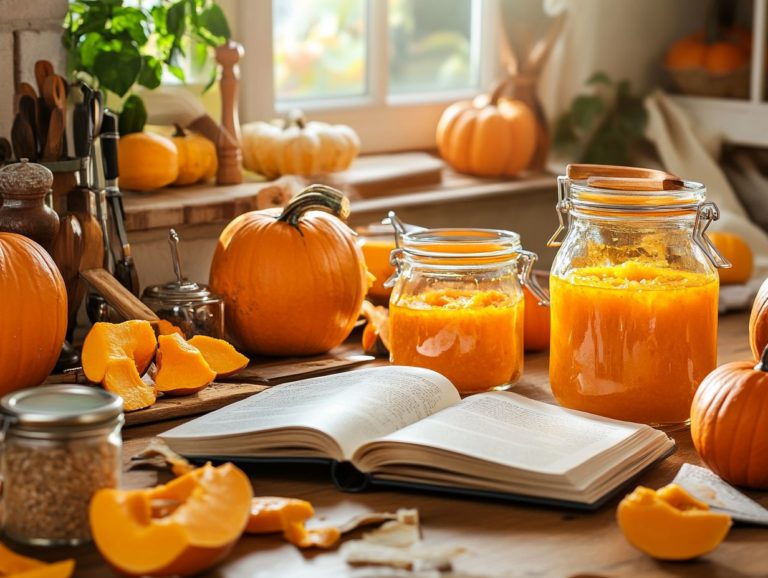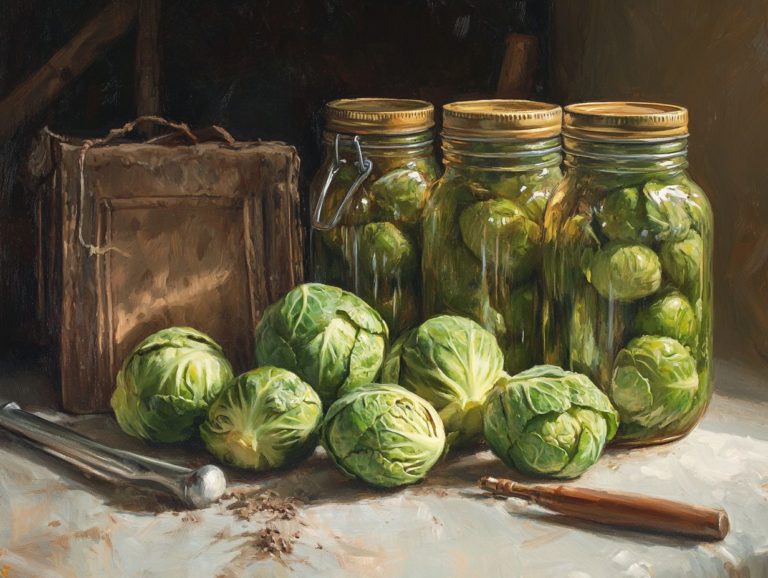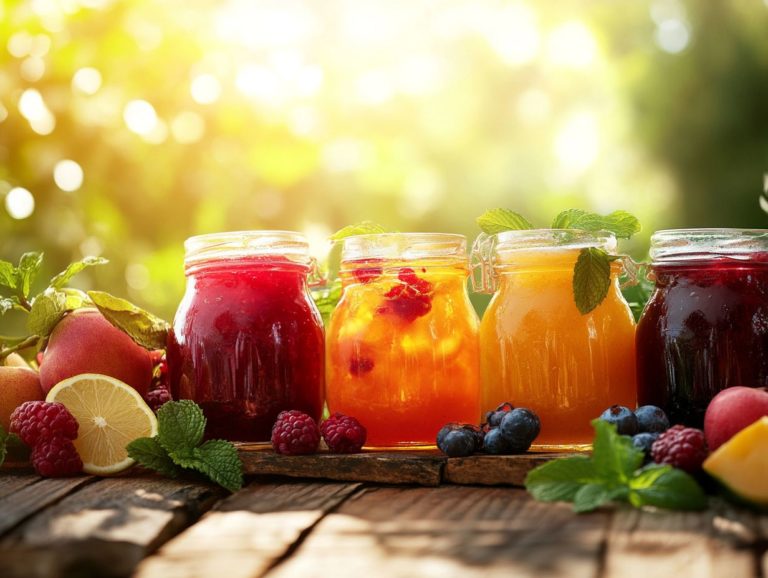Top 10 Fruit Preserves for Canning
Fruit preserves are a great way to capture the essence of summer right in your pantry, transforming fresh, seasonal fruits into sweet, spreadable treats.
Imagine the vibrant sweetness of strawberry preserves or the unique richness of fig preserves; each variety has its own charm and cooking possibilities.
This guide explores the top 10 fruit preserves you can make at home, complete with tips for canning, creative uses, and common pitfalls to avoid.
Get ready to elevate your pantry with these amazing creations!
Contents
- Key Takeaways:
- 1. Strawberry Preserves
- 2. Peach Preserves
- 3. Raspberry Preserves
- 4. Blueberry Preserves
- 5. Apricot Preserves
- 6. Blackberry Preserves
- 7. Cherry Preserves
- 8. Fig Preserves
- 9. Plum Preserves
- 10. Delicious Orange Preserves That Brighten Your Day!
- What Is the Difference Between Jam, Jelly, and Preserves?
- What Are the Benefits of Making Your Own Fruit Preserves?
- What Are the Key Ingredients Needed for Canning Fruit Preserves?
- How Can You Ensure Your Fruit Preserves Are Safe to Eat?
- What Are Some Creative Ways to Use Fruit Preserves?
- What Are Some Common Mistakes to Avoid When Making Fruit Preserves?
- What Are Some Tips for Successful Canning of Fruit Preserves?
- How Can You Store and Preserve Your Homemade Fruit Preserves?
- What Are Some Fun and Unique Flavor Combinations for Fruit Preserves?
- How Can You Incorporate Fruit Preserves into Your Everyday Meals?
- Frequently Asked Questions
Key Takeaways:
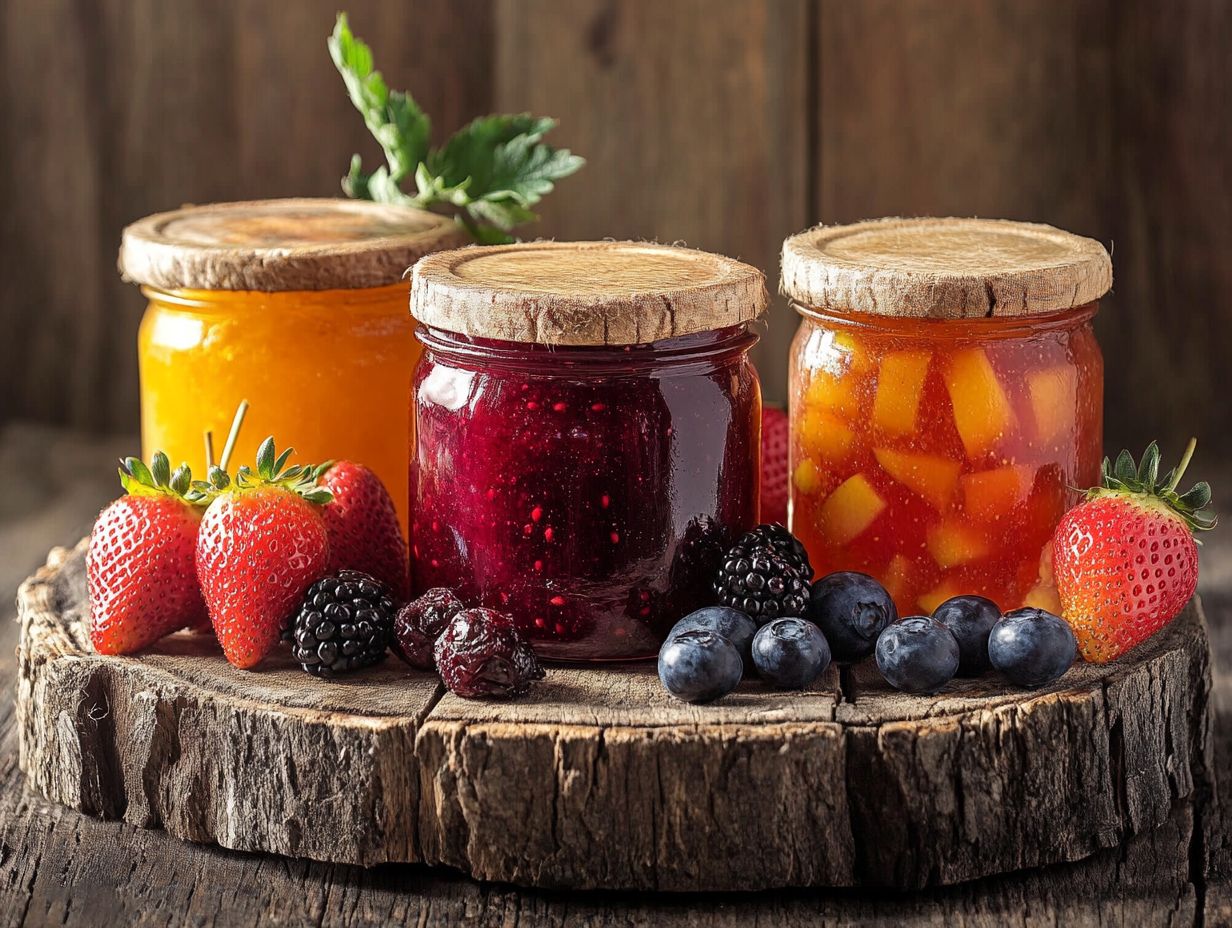
- Experiment with unique flavor combinations, such as peach and fig or raspberry and orange, for delicious and unexpected fruit preserves.
- By making your own fruit preserves, you control the ingredients and can avoid added sugars and preservatives.
- Proper canning techniques, which are methods for safely preserving food in jars, and safe storage ensure your homemade fruit preserves are safe to eat and last for months.
1. Strawberry Preserves
Strawberry preserves are the perfect way to capture summer, transforming fresh strawberries into a sweet and vibrant spread that can enhance any meal or snack.
Using canning recipes, you preserve the fruit’s delightful flavor and get to indulge in those seasonal favorites all year round.
To start, selecting ripe strawberries is essential. Look for those that are bright red and fragrant, indicating peak sweetness.
After washing and hulling the strawberries, cook them with sugar to create a luscious, thick consistency. Canning methods ensure that your preserves remain fresh and flavorful for months, and employing a water bath canning technique helps seal in that just-picked taste.
Whether you spread it on toast, drizzle it over pancakes, or stir it into yogurt, homemade strawberry preserves add a delightful twist to various dishes.
Consider variations, like adding a splash of balsamic vinegar or mixing in fresh herbs, which can create unique flavor profiles that surprise and delight your palate.
2. Peach Preserves
Peach preserves are a delightful and aromatic addition to your pantry, capturing the essence of sun-ripened peaches in a jar you can savor all year round.
To truly enjoy this seasonal treasure, it s crucial to select local, fresh peaches, as their ripeness and flavor will directly influence the final taste of your preserves.
When choosing peaches, aim for those that yield slightly to pressure and have a vibrant color these are indicators of perfect sweetness.
Washing and pitting the fruit is just the beginning; then, chop them into chunks.
For an exquisite balance of sweetness and acidity, consider adding a splash of lemon juice. Not only does it enhance the flavor, but it also helps preserve that lovely vibrant color.
The canning process may seem intimidating, but with the right techniques like using sterilized jars and careful boiling you can create a batch of peach preserves that captures the essence of summer in every spoonful.
3. Raspberry Preserves
Raspberry preserves deliver a delightful burst of flavor in every spoonful, striking a perfect balance between sweet and tart notes that can elevate various dishes and desserts.
To capture the essence of these delectable preserves, you must begin with fresh raspberries, as their vibrant taste is critical for achieving a superior result.
When selecting your fruit, aim for ripe, plump berries, which will provide the best flavor and texture.
The process starts with washing and stemming the fruit, followed by mashing it to release its natural juices.
By adding sugar and a dash of lemon juice, you ll balance sweetness and acidity beautifully, while pectin a natural thickener found in fruits ensures the consistency is just right.
Once you cook the mixture to perfection, employing proper canning techniques is vital to preserve maximum flavor and prevent spoilage.
These raspberry preserves can serve as an exquisite topping for toast, a delightful filling for pastries, or an exceptional complement to cheeses, making them a versatile addition to your culinary repertoire.
4. Blueberry Preserves
Homemade blueberry preserves offer a delightful opportunity to relish the essence of fresh blueberries, transforming them into a sweet, spreadable indulgence that highlights their rich, vibrant flavors.
To embark on this cooking experience, select the finest blueberries. Look for plump, firm berries with a deep blue hue and a slight bloom, which indicate freshness.
Once you’ve gathered your treasures, gently rinse them, ensuring you remove any stems or blemished fruit.
The canning process begins with combining the blueberries with sugar and a splash of lemon juice, then simmering the mixture to coax out its natural pectin, which is key to achieving that smooth, luscious texture.
For a touch of creativity, consider using your preserves as a topping for yogurt or pancakes, or swirl them into cottage cheese for a wholesome snack. Embrace the joy of experimenting in the kitchen; it often leads to delightful discoveries! Try making these preserves at home and savor the fresh taste of summer all year long!
5. Apricot Preserves
Apricot preserves are a sumptuous delight that captures the irresistible sweetness of ripe apricots, making them an exquisite addition to both your breakfast and dessert repertoire.
These preserves serve not only as a delectable topping for your toast and scones, but also elevate the flavor profiles of various culinary creations. To embark on the rewarding journey of making apricot preserves, begin by selecting perfectly ripe apricots; their vibrant flavors are essential for achieving the best results.
The canning process is crucial, as it intensifies the sweetness and locks in nutrients, allowing you to savor that bright taste of summer all year round. If you’re feeling adventurous, consider using apricot preserves as glazes for meats or as a sweet element in salad dressings, merging tradition with your culinary creativity. Try making these preserves at home and enjoy a taste of summer anytime!
6. Blackberry Preserves
Blackberry preserves offer a perfect mix of sweet and tart, capturing the essence of fresh blackberries in a jar that s sure to impress, whether spread on toast or drizzled over dessert.
To truly elevate this exquisite condiment, begin with juicy, ripe blackberries. Their flavor is crucial for the quality of your preserves. By carefully selecting berries at their peak ripeness, you ensure that the natural sweetness harmonizes perfectly with just the right hint of tartness, resulting in a preserve that resonates with authenticity.
Once the fruit is prepped, the canning process not only locks in those vibrant flavors but also preserves their color and nutrients, transforming each spoonful into a burst of summer delight. Beyond simply spreading it on bread, these preserves can elevate a range of culinary creations from topping pancakes and waffles to enhancing savory dishes like glazed meats or infusing a tangy BBQ sauce with a touch of sophistication. Try making these preserves at home and enjoy the vibrant flavors!
7. Cherry Preserves
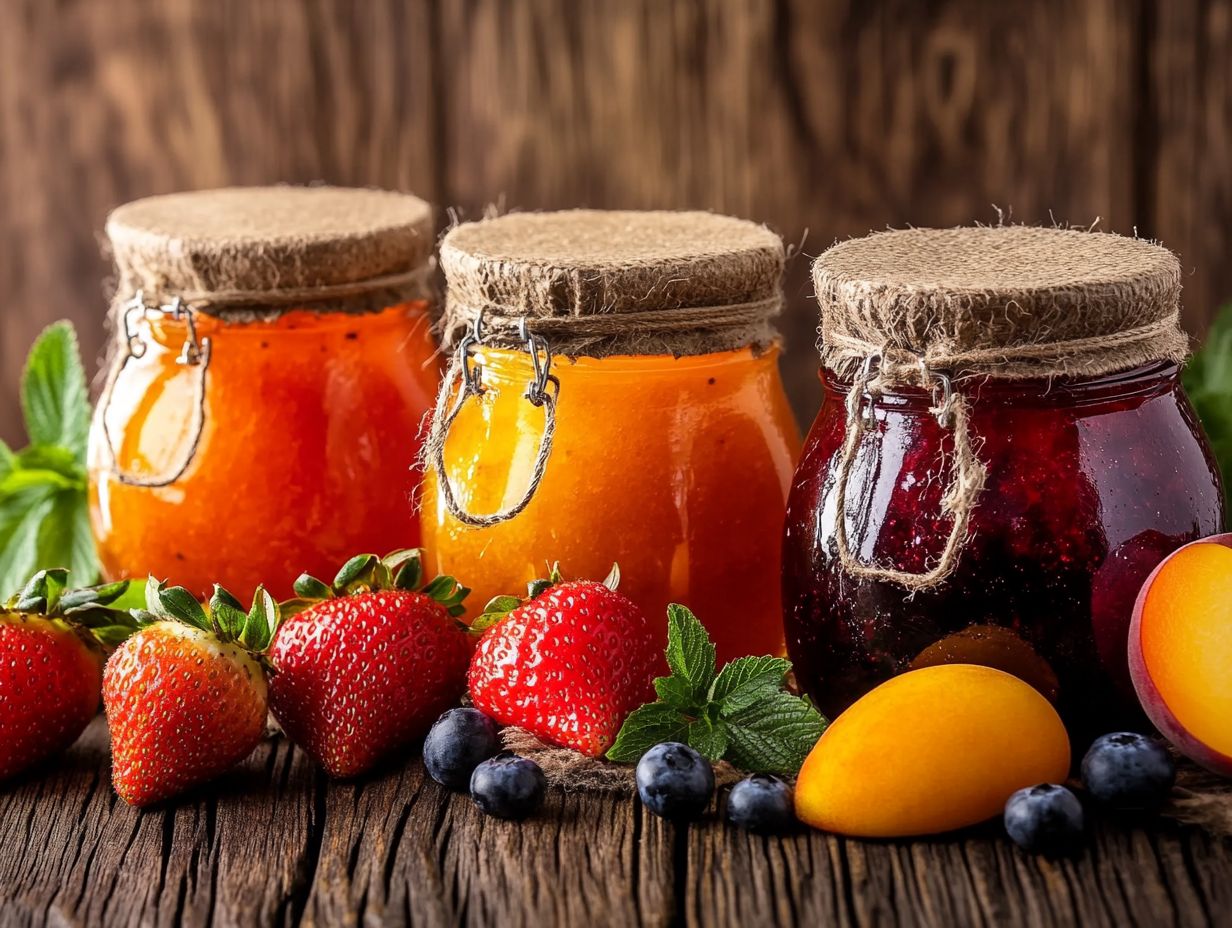
Cherry preserves offer a delightful burst of sweetness paired with a hint of tartness, capturing the exquisite essence of cherries in a homemade spread that elevates any culinary creation.
To embark on this delightful journey of crafting these preserves, start by selecting the finest cherries, typically at their peak during the summer months. Seek out plump, vividly colored fruit that strikes a harmonious balance between sweetness and tang, ensuring a rich flavor profile in your final product.
Once you’ve made your selection, the canning process commences, requiring meticulous preparation and proper sealing techniques to lock in the cherries vibrant taste. These spreads pair beautifully with an array of delights, from fresh cheese to breakfast pastries, making them a versatile addition to your culinary repertoire.
The seasonal nature of cherry preserves serves as a gentle reminder to savor summer s bounty while it s still within reach. Try making these preserves at home and enjoy the sweet taste of summer all year long!
8. Fig Preserves
Fig preserves are a unique and luscious treat. They transform the delightful sweetness of fresh figs into a rich spread that elevates both savory and sweet dishes.
To create this delectable preserve, start by selecting the right figs. Choose ripe, plump figs; they ll bring a naturally sweet flavor and the perfect texture to your final product. After gently washing them, remove the stems and cut the figs into small pieces for even cooking.
In canning, the versatility of fig preserves truly shines. Imagine these delicious preserves elevating your cheese platters and pairing beautifully with roasted meats. They can also serve as a glaze on pastries, making them an essential addition to your pantry.
9. Plum Preserves
Plum preserves capture the succulent sweetness of ripe plums. This delightful spread can elevate your breakfast or dessert to new heights.
To craft your own homemade plum preserves, begin by selecting the finest seasonal plums. Ensure they are perfectly ripe to unlock their full flavor potential. Once you ve washed and pitted the fruits, chop them up and combine them with sugar and a hint of lemon juice to enhance the acidity.
As you simmer the mixture, watch it transform into a thick, jam-like consistency in about 15 to 25 minutes.
Next, sterilize your jars and lids for a perfect seal. After filling the jars, process them in a boiling water bath a method of immersing jars in boiling water to kill bacteria for longevity. These preserves are great on toast, drizzled over yogurt, or even used as a sauce for savory dishes, showcasing their versatility.
10. Delicious Orange Preserves That Brighten Your Day!
Orange preserves offer a sweet and tangy flavor, bringing a touch of sunshine to your table. They transform fresh oranges into a delightful spread full of vibrant tastes.
The secret to creating these preserves lies in the important parts of both zest and juice. They infuse the mixture with a burst of citrus brightness and help achieve a perfect harmony between sweetness and acidity.
By finely grating the orange peel, you maximize the oil content, enhancing the preserve’s aromatic qualities. The freshly squeezed juice elevates its overall flavor profile.
Once prepared, these preserves shine in various dishes. You can slather them on toast, dollop them over vanilla ice cream, or use them as a glaze for roasted meats. They add a unique twist that elevates any meal.
What Is the Difference Between Jam, Jelly, and Preserves?
Understanding the distinctions between jam, jelly, and preserves is essential for anyone diving into canning recipes. Each option brings its own unique textures and flavors to your culinary endeavors.
These fruit spreads differ not just in ingredients but also in preparation methods. For instance, jam is made from crushed or pureed fruit mixed with sugar and pectin, resulting in a chunky yet spreadable consistency, perfect for your morning toast.
Jelly is crafted from fruit juice, sugar, and pectin, yielding a smooth, clear texture free of any fruit pieces ideal for those who prefer a more refined spread. On the other hand, preserves feature larger chunks or whole pieces of fruit suspended in syrup, giving them a hearty, rustic charm.
Consider strawberry jam, which balances sweetness with bits of fruit. Then there’s grape jelly, offering a silky-smooth experience. Finally, apricot preserves showcase delightful fruit pieces that deliver both flavor and texture.
Explore these spreads and discover which one excites your taste buds the most! Don t miss out on trying to make your own preserves!
What Are the Benefits of Making Your Own Fruit Preserves?
Making your own fruit preserves brings a wealth of benefits. You get to choose fresh, local fruit, control the ingredients, and enjoy the satisfaction of crafting homemade treats bursting with vibrant flavors.
Homemade fruit preserves offer notable health benefits. By opting for natural sweeteners and avoiding preservatives, you can savor the pure essence of fruit while minimizing artificial additives.
Additionally, creating your own preserves is a smart choice that saves money, especially when you take advantage of the seasonal bounty from farmer s markets or your backyard garden.
The process of experimenting with different fruits and flavors can spark your creativity. You can customize recipes to suit your personal taste. Plus, sharing these hand-crafted delights with friends and family enhances the experience, making it a wonderful way to foster connections and celebrate the seasons.
What Are the Key Ingredients Needed for Canning Fruit Preserves?
To successfully can fruit preserves, you must understand the essential ingredients typically sugar, pectin, and the right level of acidity to ensure both flavor and safety.
Each of these components is important in the preservation process. Sugar sweetens your mixture and acts as a preservative by drawing moisture out of the fruit, which inhibits microbial growth. When selecting sugar, consider whether granulated, brown, or specialty varieties best suit your desired flavors and textures.
Pectin is a natural thickener found in fruits that helps your preserves set properly. Your choice between liquid or powdered pectin can affect the final outcome, depending on the specific recipe and the acidity of the fruit.
Acidity, measured by pH, is critical for safe preservation. It helps maintain the quality of your preserves and prevents spoilage while enhancing the fruit’s vibrant flavor. Adjusting acidity can also influence the texture and taste, so understanding these details is key to mastering canning.
How Can You Ensure Your Fruit Preserves Are Safe to Eat?
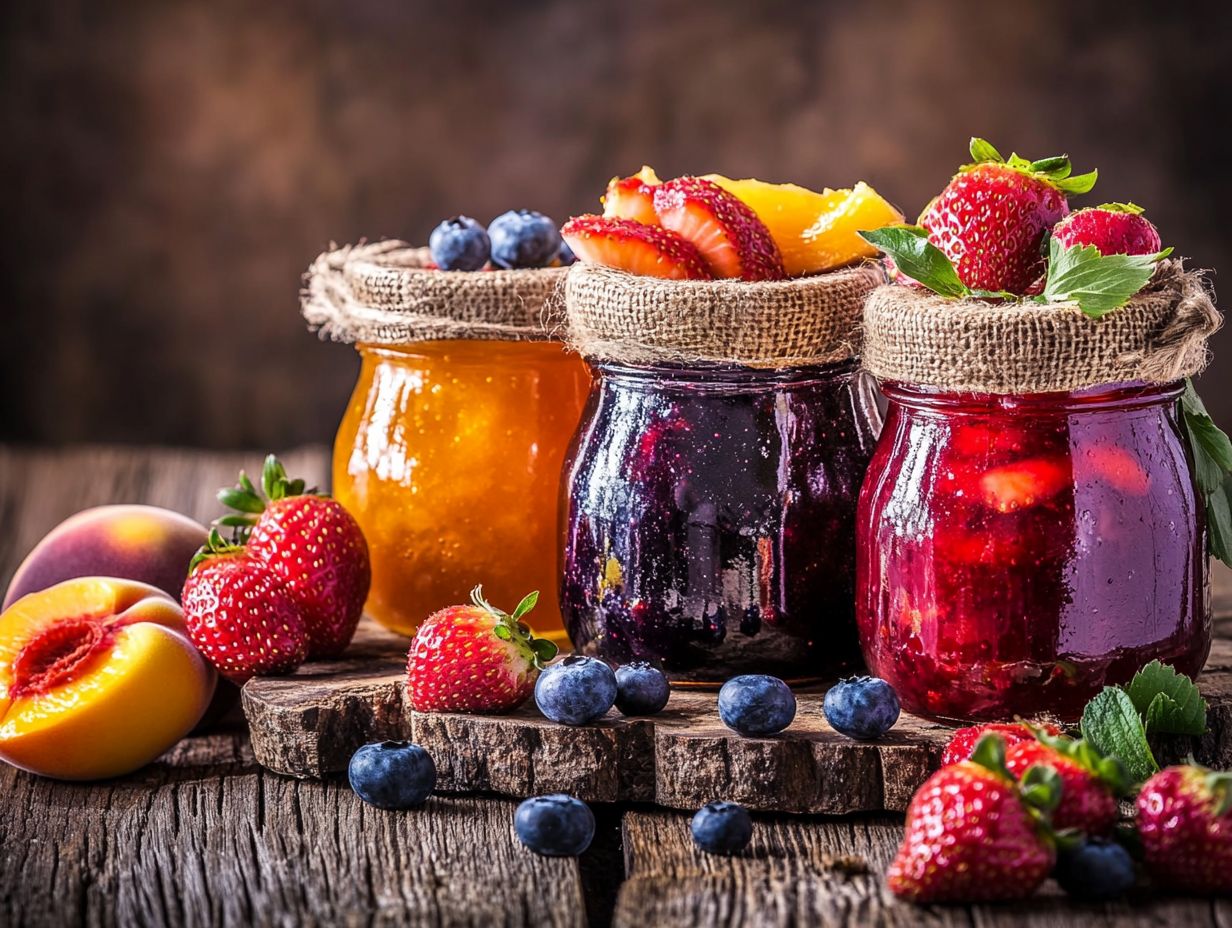
Ensuring the safety of your fruit preserves is absolutely essential. By following proper canning techniques such as sterilization and monitoring acidity levels you can effectively prevent spoilage and foodborne illnesses.
Start with thoroughly cleaned and sterilized jars to eliminate any potential contaminants. You can easily ensure safety by boiling your jars or using a high-heat dishwasher for quick sterilization!
For acidity, finding the right balance is crucial. Generally, high-acid fruits like berries require less acidity than their low-acid counterparts, so keep this in mind for optimal preservation.
After canning, check the seals on your jars. The lids should be concave and secure, with no popping sounds when reopened. By paying attention to these critical steps, you can enjoy delicious and safe homemade preserves with confidence.
What Are Some Creative Ways to Use Fruit Preserves?
Fruit preserves are far more than a simple spread for your toast; they can be integrated into a variety of dishes, adding both savory and sweet flavors.
This versatility opens up a world of culinary possibilities for you as a home cook. Picture yourself adding a generous dollop of fruity goodness to your morning oatmeal or swirling it into yogurt for an instant flavor boost.
In savory dishes, fruit preserves can enhance marinades for meats, adding caramelized notes that elevate grilled chicken or pork. They also make a fabulous addition to dressings, providing a unique twist that beautifully balances sweenness and acidity in salads.
When used as toppings for desserts like cheesecake or ice cream, you can transform an ordinary dish into a gourmet experience. So, don t hesitate to experiment with your homemade preserves; the results may just amaze your taste buds!
What Are Some Common Mistakes to Avoid When Making Fruit Preserves?
Many home canners stumble into common mistakes that can derail their fruit preserves, like overcooking the fruit or miscalculating the sugar-to-fruit ratio.
These missteps can lead to products that lack flavor or the desired texture. This can leave you disappointed after all that hard work. To sidestep these blunders, following exact recipes is key to your success! Pay close attention to cooking times.
For example, one experienced jam maker almost ruined her peach preserves by failing to measure the sugar accurately. This resulted in an overly sweet and syrupy concoction. Now, she swears by using a kitchen scale, a tool for measuring ingredients accurately, for perfect ratios every single time.
It s also critical to pay attention to the acidity levels of your fruit. Insufficient acidity can lead to spoilage. With a little practice and diligence, you can easily avoid these pitfalls and create jars of delightful preserves that you can be proud of.
What Are Some Tips for Successful Canning of Fruit Preserves?
Successful canning of fruit preserves requires careful preparation and attention to detail. Every step from selecting the fruit to sealing the jars must be executed with precision.
Your journey begins with choosing the freshest, ripest fruit. This choice will significantly elevate the flavor of your final masterpiece. Seasonal delights like strawberries and peaches not only burst with vibrant taste but also enhance preservation.
Once you ve selected the fruit, wash, peel, and cut it with care. This step maintains both hygiene and texture. Following ideal cooking times specific to each type of fruit guarantees that your preserves achieve the perfect consistency without any undesirable separation.
Mastering the art of sealing jars correctly safeguards against spoilage, preserving the deliciousness you ve meticulously crafted.
How Can You Store and Preserve Your Homemade Fruit Preserves?
Proper storage of your homemade fruit preserves is essential for maintaining their flavor and safety. Keep them in a cool, dark place, far away from the sun’s rays.
Pay attention to the types of jars you use. Opt for jars specifically designed for canning, as they provide a tighter seal and enhance preservation. Ensuring that seals are intact is crucial. When you open a jar, listen for that satisfying popping sound it s your indicator of a proper vacuum seal.
Regularly check your preserves for any signs of spoilage, like unusual odors, colors, or mold. Keeping an eye out for spoilage helps prevent foodborne illnesses and extends the shelf life of your delightful homemade treats.
What Are Some Fun and Unique Flavor Combinations for Fruit Preserves?
Exploring fun and unique flavor combinations for fruit preserves opens the door to delightful creations, where sweet and savory elements converge to deliver a truly distinctive taste experience.
As you experiment with various fruit pairings, endless possibilities await to be unlocked. Get ready to be amazed by the magic of mixing peaches with fresh basil or strawberries with a hint of cracked black pepper these choices transform a simple preserve into something extraordinary.
Incorporating citrus zest, like orange or lime, adds an unexpected zing that brightens the overall flavor profile. Don t hesitate to introduce herbs like rosemary or thyme; these can create a delightful contrast that surprises and delights your palate.
The key is to play with ingredients and discover what pairings resonate best with you, unleashing your creativity in the kitchen.
How Can You Incorporate Fruit Preserves into Your Everyday Meals?
Incorporating fruit preserves into your everyday meals can truly elevate your cooking experience. They offer delightful versatility in both sweet and savory dishes that will surprise and please your palate.
Imagine whisking a tangy apricot preserve into a marinade for chicken dishes, infusing the meat with a delightful sweetness that harmonizes beautifully with savory herbs. Picture a dollop of blackberry preserve transforming a simple cheese board into an exquisite appetizer, pairing perfectly with creamy cheeses and crunchy crackers.
Consider using citrus preserves to create a bright glaze for roasted vegetables or as a flavorful sauce over grilled fish. The adaptability of these preserves makes them a wonderful addition to various cuisines.
Whether you re crafting a classic French tart or grilling up a hearty barbecue dish, there s likely a fruit preserve that can enhance the overall flavor profile. This can make even the simplest meals feel gourmet.
Frequently Asked Questions

What are the top 10 fruit preserves for canning?
The top 10 fruit preserves for canning are strawberry, raspberry, blueberry, peach, apricot, blackberry, cherry, plum, fig, and apple. To enhance your canning experience, consider the top 10 ingredients to stock for home canning.
Why are these fruits ideal for canning?
These fruits are ideal for canning because they have a high sugar and acid content. This makes them naturally resistant to bacteria and able to preserve for a longer period of time.
What Tools Do You Need for Canning Fruit Preserves?
To can fruit preserves, you will need canning jars, lids and bands, a large pot for boiling water, a canning rack, a funnel, a ladle, and a jar lifter.
What is the Process for Canning Fruit Preserves?
The process for canning fruit preserves involves sterilizing the jars, preparing the fruit and syrup, filling the jars with the fruit and syrup, sealing the jars, and processing them in a boiling water bath for the recommended time.
How Long Can Canned Fruit Preserves Last?
If stored in a cool, dark place, canned fruit preserves can last an impressive 1 year. It is important to check the seals on the jars and discard any that have become unsealed or show signs of spoilage.
Can I Customize the Sugar Content in My Fruit Preserves?
Yes, you can customize the sugar content in your fruit preserves. However, it is important to follow a tested recipe and not reduce the sugar content too much, as it helps with the preservation process.
Ready to start canning? Gather your supplies and get started on your fruit preserve adventure today!

